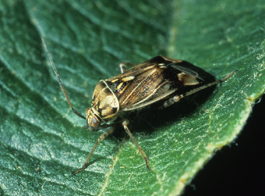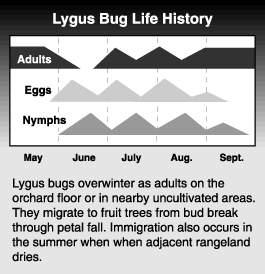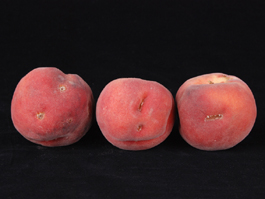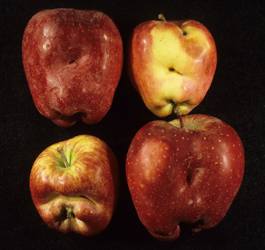by E.W. Anthon, originally published 1993
Lygus lineolaris (Palisot de Beauvois) (Hemiptera: Miridae)
Lygus bugs attack many field and vegetable crops and often attack tree fruits, particularly where they are near uncultivated land or alfalfa fields. Lygus bugs are found in Europe, Asia, and throughout the United States and southern Canada. Lygus lineolaris, also known as the tarnished plant bug, is the most prevalent species attacking tree fruits in the Northwest, but the brown lygus (Lygus hesperus) and the green lygus (Lygus elisus) are also common.
Hosts
The many hosts of lygus bugs include alfalfa, sweet clover, mullein, Russian thistle, smotherweed, horseweed, wild mustards, western ragweed, rabbitbrush and sagebrush. Green lygus prefers Mexican fireweed over most other plants. Lygus adults will also attack apples, pears, peaches and apricots but do not reproduce on those hosts.
Life stages
Egg

The egg is creamy white and 1/25 inch (1 mm) long. It is flask shaped and truncate at the wider end, which has a flat cap. It is inserted into plant tissue with only the cap exposed.
Nymph
The nymph is pale yellow or green. It resembles the adult but is smaller and has no wings. It develops through five instars. The third to fifth instars have distinct spots on the thorax and abdomen.
Adult
The adult L. lineolaris varies from pale green to dark brown, with yellow, black and sometimes reddish markings. It has a yellow triangular region, called the scutellum (a feature shard by all true bugs in the family Hemiptera), on the upper center of the back. It is about 1/4 inch (6 mm) long. The male is generally darker than the female. The brown lygus is pale yellow to brown with darker brown, black and red markings. The green lygus is pale and bright green.
Life history
 There are three generations a year and sometimes a partial fourth in the Northwest. Lygus bugs overwinter as adults beneath weeds or duff on the orchard floor or in nearby uncultivated areas. A favorite overwintering site is between the dead leaves of mullein. Adults become active in the spring and fly to fruit trees, where they feed on developing flower buds. Apples are most susceptible to damage between early pink stage of bud development through 2 weeks after petal fall. On peaches, adults appear when the buds are in the pink stage and are most abundant at petal fall. Most adults leave trees soon after petal fall to feed on weed hosts or other crops.
There are three generations a year and sometimes a partial fourth in the Northwest. Lygus bugs overwinter as adults beneath weeds or duff on the orchard floor or in nearby uncultivated areas. A favorite overwintering site is between the dead leaves of mullein. Adults become active in the spring and fly to fruit trees, where they feed on developing flower buds. Apples are most susceptible to damage between early pink stage of bud development through 2 weeks after petal fall. On peaches, adults appear when the buds are in the pink stage and are most abundant at petal fall. Most adults leave trees soon after petal fall to feed on weed hosts or other crops.
Lygus bugs prefer to lay eggs on plants about to flower, and thus move from host to host according to the timing of bloom. Females lay eggs about 10 days after emerging. They insert eggs into the leaves or stems of primary host plants, such as broad-leaved weeds. The eggs hatch in 1 to 4 weeks, depending on the temperatures. Nymphs feed on these plants by piercing the tissue and extracting the juices. Nymphs do not move into fruit trees.
Lygus bug adults may move into orchards at any time when host plants in surrounding rangeland begin to dry or crops like alfalfa are cut.
Damage
Pome fruit
Most feeding damage is done just before or after bloom. Adults puncture buds and remove juices from the flower parts. Severely damaged buds shrivel and dry before they open. Buds that have been fed on sometimes exude a clear drop of liquid. If the terminal bud is killed, shoot growth in young trees can be distorted, altering the desired training form. The most important damage occurs when adults feed on flower parts or young fruit. This feeding kills some cells in the fruit, which fail to grow, leaving the fruit deformed with deep pits. Females deposit eggs in young fruit, causing shallow pitting and deformity.
Stone fruit
Feeding by lygus bugs causes cat-facing and dimpling, which tends to be more severe on stone fruit than pome fruit. Cat-facing is a term used for rough, corky areas on the fruit. Damaged fruit has sunken spots where the flesh has dried out. Fruit is deformed because surrounding areas grow more quickly than the damaged parts.
Monitoring
Lygus bugs can be monitored by using a sweep net to sample the ground cover, limb jarring or visual examination. Because most damage is done around bloom, monitoring should begin in April near the borders of the orchard to detect the bugs as early as possible.
Biological control
Several parasitoids attack eggs, nymphs and adults. The braconid wasp Peristensus pallipes attacks nymphs, and the mymarid wasp Anaphes ovijentatus attacks eggs. Big-eyed bugs, damsel bugs, assassin bugs and crab spiders are important natural enemies and can help control lygus bug nymphs on host plants outside the orchard or on the cover crop.
Management
Lygus bugs do not reproduce on tree crops so problems can be alleviated by removing alternate hosts. Cover crops containing mostly grasses and few alternate hosts for lygus bugs will help minimize populations in the orchard. Where possible, destruction of weed hosts, such as mullein, outside the orchard can help reduce numbers of adults migrating into the orchard in spring and summer.
If lygus bugs are in the orchard before bloom, or if the orchard has a history of lygus bug damage, chemical controls should be applied during the delayed-dormant or pre-pink stage of tree development. Opening lower nozzles on the sprayer can help improve control. Lygus bugs tend to stay in the cover crop while temperatures are cool and move into the tree during the heat of the day.
If lygus bugs are moving in from drying rangeland or a nearby crop, such as alfalfa, border treatments can reduce numbers and damage. When alfalfa fields are cut, large number of lygus adults can suddenly move into orchards. Border treatments of six rows can help stop movement throughout the entire orchard.
Materials available for apple
Excerpt from the WSU Crop Protection Guide. For timings at which each pesticide can be used refer to the Crop Protection Guide.
Materials available for pear
Excerpt from the WSU Crop Protection Guide. For timings at which each pesticide can be used refer to the Crop Protection Guide.
Use pesticides with care. Apply them only to plants, animals, or sites listed on the labels. When mixing and applying pesticides, follow all label precautions to protect yourself and others around you. It is a violation of the law to disregard label directions. If pesticides are spilled on skin or clothing, remove clothing and wash skin thoroughly. Store pesticides in their original containers and keep them out of the reach of children, pets, and livestock.
YOU ARE REQUIRED BY LAW TO FOLLOW THE LABEL. It is a legal document. Always read the label before using any pesticide. You, the grower, are responsible for safe pesticide use. Trade (brand) names are provided for your reference only. No discrimination is intended, and other pesticides with the same active ingredient may be suitable. No endorsement is implied.
Articles from the Tree Fruit website may only be republished with prior author permission © Washington State University. Reprint articles with permission must include: Originally published by Washington State Tree Fruit Extension Fruit Matters at treefruit.wsu.edu and a link to the original article.

